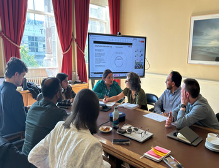It’s this stark: our precious public services cannot possibly survive for much longer in their current form. Take social housing, for example. The sector is suffering from a ‘perfect storm’ of a major cost of living crisis, inflation in the cost of repairs, continuing fallout from the 2015–19 rent reductions, ageing property portfolios, erosion of housing stock from buy-to-let, energy efficiency retrofits, a risky housebuilding environment, government pressure to build more houses to compensate for the exit of private landlords, and an increasing regulatory burden (Renters Reform Bill, Social Housing Act, etc). Surely, no sector could reasonably respond to all this within existing budgets?
But not so fast: maybe that’s just not true. What if there was actually more than enough money for us to enjoy brilliant social housing, and the reason we don’t is because we just don’t have the technology and systems to join it all up and organise ourselves effectively?
Like most of our local services, housing has become infested with corporate activity (the “office stuff” such as HR, finance, management, marketing, IT, consultants, auditors, and the rest). If you think ‘infested’ sounds a bit strong, I’m reliably informed that such activity accounts for around 40% of social housing’s budget.
With so much suffering across the sector, it’s important to question how such a terrible situation has been allowed to happen. I believe the answer is simple. We have around 1,600 housing providers, and each one has to maintain all that ‘office stuff’ (see above), over, and over, and over again. To get an idea about how this plays out, imagine if Tesco had to maintain ‘office stuff’ for each of its 3,433 UK stores, so that each had its own IT system, processes, administration etc, each its own with minimal collaboration with any of the others. You can easily imagine how expensive and inefficient these shops would be: ‘transformation’ programmes teetering, top-heavy, over the top of each shop. As customers, we’re free to vote with our feet if commercial organisations had to behave this way, whereas customers of social housing aren’t so fortunate because they lack a choice. Any commercial organisation with 40%+ overheads wouldn’t last a year.
So why do we continue to work this way? Surely, it’s wrong?
A major reason for our continued tolerance is that ‘localism’ – the perfectly understandable idea that local people should have services tailored around their specific needs – is routinely held up to justify spending all this money not on providing local housing, but instead on having to duplicate this local ‘office stuff’ as well. In the digital era however, are such arguments wrong, given it doesn’t have to be this way? As the ‘anything-anytime-anywhere’ example of Amazon or Etsy proves, the more you share the back-end ‘office stuff’, collecting together all that shared data, insights and pooled resource power, the more closely you can anticipate and deliver to the requirements of everyone, no matter where in the country they live, or how. If we decided to run social housing like Etsy or Tesco, we’d still have 1,600 local providers, but this time instead of spending 40% of their budgets managing the back office, we could perhaps spend 85% of the social housing budget on – social housing [1].
And it’s not just the physical housing that would improve: the service would improve, too. Local housing providers would be able to focus on their local housing, and consume almost all their ‘office stuff’ from the centre: I’m thinking smart homes; payments; complaints; antisocial behaviour; tenant satisfaction measures/surveys/complaints; legal services; HR; dynamic scheduling, optimising repair journeys between providers; recruitment; rent reviews; customer insight using AI; contact centre – first-line support; regulatory reporting; collective purchasing (building materials, blocked drains, pest control, etc), and service charges. Providers might even share an expert ‘policy unit’ to interpret rolling legislation/regulatory requirements and best practice: currently, most housing providers each have 2-3 FTEs just maintaining pace with this, so nationally 3,000+ staff just reinterpreting government policy, inconsistently).
I focused on social housing as an example (apologies to all the good people who struggle within this current system to provide decent housing to others in need), but I might just as easily have picked on other areas in the public sector.
How much longer must we all fail to look at solutions for those most in need and rethink our vision?
Why I Chair the Impact Council powered by We Are Group
I should emphasise that the sense of outrage that permeates my description of the problem – and the opportunity before us – is my own, and not that of We Are Group; this is my blog, not theirs. However, as a social impact company, We Are Group is moving the dial by offering digital, and human, ‘connective tissue’ between our fractured welfare services, and I applaud this.
By offering customers a joined-up, ‘tell us once’ experience that makes it easy and quick to perform a range of interactions with service providers, the intention is to evolve the connective infrastructure between them all that is so needed. For me, this is an essential first step towards a centrally-provided welfare and community-led service that I believe must power our local services in the future. For example, if someone needs assistance and assistance is available they should not need to navigate through various agencies and/or charities repeating their position and seeking support along the way, nor should they miss out on other forms of entitlement. It may be that the initial request is to seek some form of guidance around completing a form but through an effective triage and assessment, they should also be able to access additional support, be that things such as free equipment and bandwidth or a financial assessment and access to free training, be that basic technology or lengthier career-enhancing opportunities with assurances around interviews and employment opportunities.
As one might expect for such a task, We Are Group powers an Impact Council that it can draw on for ideas, challenge/critique, and encouragement: being visionary is never an excuse for being naïve. Whilst I may have demonstrated, above, that my own leaning is towards the disruptive, others on the Council are much more level-headed: the Council comprises 54 senior thought leaders drawn from financial services, local authorities, social housing, NHS, academics, ISPs. Whatever our personal approach and expertise, however, we all share a genuine passion for building this connective tissue – and conviction that, somehow, This Must Happen. Like all new ideas requiring changes in collective behaviour, persuading service providers to work alongside We Are Group’s ‘connective tissue’ to better join up around customers will require networking, credibility, and persistence. I believe the Council has this in spades.
19th October 2023 was our second quarterly meeting, in We Are Group’s new Coventry offices, and offered a chance for in-depth discussions on a range of topics that, as usual, expanded our understanding about the task ahead. Examples of this dynamic in action include the way that a conversation about trust and data security evolved into one about partner strategy, which in turn evolved further into one about three-sided platforms (for We Are Group, these sides are customers, service partners, and funders). Or how the conversation about triaging requirements, and passporting of data between partners, became one about the eventual possibility of a 111-style service, or gov.uk, for vulnerable people. The planning was wonderfully organised, the environment professional, and the conversation earnest, informed, and pragmatic.
Working in a business school, I am acutely aware of the way in which inefficient sectors replete with non-value-adding middlemen/women have been crumbling in the face of the twin pressures of increased costs and the rise of new, digital ways of joining up, sharing, and personalising. As commercial customers, we are instinctively aware of the way in which these changes have brought about more personalised, convenient services, and we enthusiastically use them; but as government customers, we put up each day with the sort of offerings that – but for our collective inertia – should have been consigned to the dustbin many years ago. Our behaviour in this way is almost schizophrenic.
This is why I feel honoured to chair the Impact Council: because, in their own way, they’re trying to do something about it, and I fervently hope that they succeed.
Prof Mark Thompson, Chair Impact Council
Powered by We Are Group
20 October 2023
[1] McKinsey estimates that admin costs such as IT, HR, and Finance typically consume around 3-11% of total revenue; this is different from overheads, which include salary and other costs, e.g. insurance, utilities, etc.






